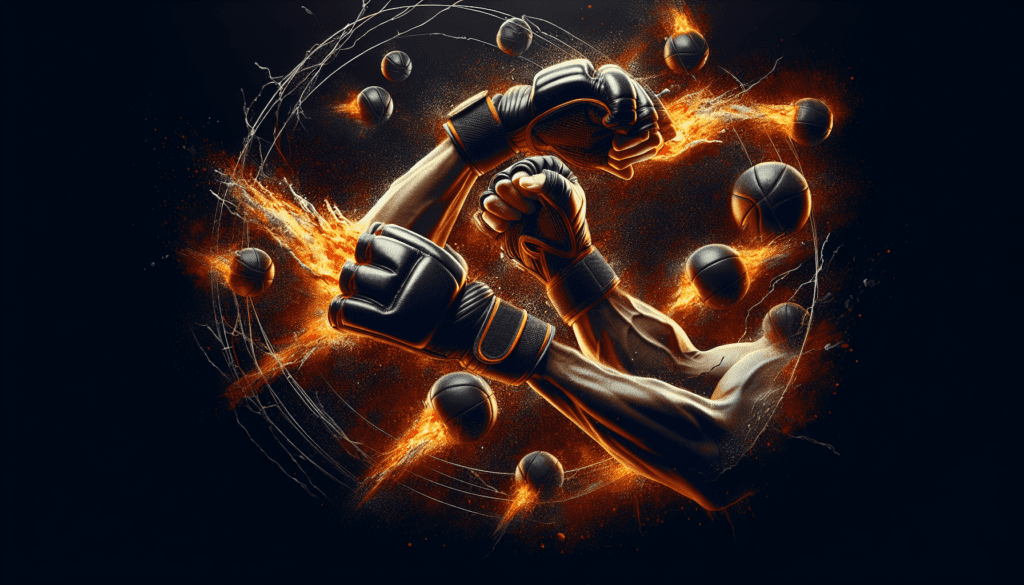In this article, you will discover a range of dynamic and powerful plyometric exercises specifically designed for MMA fighters. These exercises are not only effective for building explosive strength, but also for enhancing agility, speed, and overall athletic performance in the octagon. Whether you’re a seasoned fighter or just starting out, incorporating these plyometric exercises into your training routine can take your MMA game to the next level. Get ready to boost your power and dominate the cage with these effective plyometric exercises for MMA.

Benefits of Plyometric Exercises for MMA
Improved Power
Plyometric exercises are highly beneficial for MMA fighters as they help improve power, which is crucial in generating explosive strikes and takedowns. By engaging in plyometric exercises, such as squat jumps and box jumps, you can enhance your ability to generate force quickly, leading to more powerful punches, kicks, and takedowns.
Increased Speed and Agility
Speed and agility are vital components in MMA, allowing fighters to react swiftly to their opponent’s movements and execute rapid strikes or defensive maneuvers. Incorporating plyometric exercises into your training regime, such as tuck jumps and lateral bounds, can help enhance your speed and agility by improving your muscle reaction time and explosive power.
Enhanced Balance and Coordination
Maintaining balance and coordination is key to executing effective techniques in MMA. Plyometric exercises, like single-leg hops and depth jumps, can greatly improve your balance and coordination by challenging your stability and teaching your muscles to adapt and react quickly. This, in turn, translates to improved footwork, striking accuracy, and grappling skills.
Improved Cardiovascular Endurance
Cardiovascular endurance is essential for MMA fighters, as it allows them to sustain a high level of activity throughout a fight or training session. Plyometric exercises, such as medicine ball slams and plyometric push-ups, not only engage multiple muscle groups but also increase heart rate, improving your cardiovascular endurance over time. This enables you to maintain your performance and power even during intense rounds or extended training sessions.
1. Squat Jumps
Execution
To perform a squat jump, start by standing with your feet shoulder-width apart. Lower your body into a squat position, ensuring your knees are aligned with your toes. From this position, explosively jump up into the air, extending your legs fully. Land softly back into the squat position and repeat the jump for the desired number of repetitions.
Variations
- Weighted Squat Jumps: Hold a dumbbell or kettlebell in each hand while performing the squat jump to increase resistance and further develop power.
- Split Squat Jumps: Instead of jumping directly upward, perform a split squat by lunging forward with one leg while explosively jumping up. Switch legs on each repetition to work both sides evenly.
Benefits
Squat jumps are excellent for building lower body power and explosiveness, as they target the quadriceps, hamstrings, glutes, and calves. By incorporating squat jumps into your MMA training, you can improve your ability to generate force quickly, leading to more powerful strikes and takedowns.
2. Box Jumps
Execution
To perform a box jump, stand facing a sturdy box or platform of an appropriate height. Begin with your feet shoulder-width apart, then bend your knees and swing your arms backward. Explosively jump onto the box, extending your hips and knees fully. Land softly on the box, then step back down and repeat the movement.
Variations
- Depth Drops: Start by standing on the box, then step off and immediately jump back onto it upon landing.
- Single-Leg Box Jumps: Perform the same movement, but using only one leg at a time. This variation enhances stability and balance.
Benefits
Box jumps are highly effective in developing lower body power, explosive strength, and vertical jumping ability. By practicing box jumps regularly, MMA fighters can improve their ability to generate force from the legs, resulting in more explosive kicks, takedowns, and powerful movements inside the cage.
3. Depth Jumps
Execution
Start by standing on a sturdy box or platform. Step off the box, landing softly on the ground with your knees slightly bent. As soon as you land, explosively jump up as high as possible. This exercise focuses on the eccentric phase of the movement, which helps improve reactive strength and power.
Variations
- Double-Leg Depth Jumps: Perform the exercise with both feet landing simultaneously.
- Single-Leg Depth Jumps: Jump off the platform with one leg and land on the ground with the same leg. Alternate legs on each repetition.
Benefits
Depth jumps are a fantastic plyometric exercise for developing explosive power, reactive strength, and coordination. By practicing depth jumps, MMA fighters can enhance their ability to generate force quickly while maintaining stability, enabling them to execute powerful strikes and explosive takedowns with precision.

4. Tuck Jumps
Execution
Begin by standing with your feet hip-width apart. Lower your body by bending at the knees, then explosively jump into the air. While airborne, tuck your knees up towards your chest, grabbing them with your hands if possible. Extend your legs back out and land softly on the balls of your feet, ready to repeat the movement.
Variations
- Single-Leg Tuck Jumps: Perform the tuck jump using only one leg at a time, alternating legs on each repetition.
- Weighted Tuck Jumps: Hold a medicine ball or dumbbell in your hands while performing the tuck jump to increase resistance and further challenge your explosive power.
Benefits
Tuck jumps are phenomenal for developing explosive power, coordination, and core strength. By incorporating tuck jumps into your MMA training, you can enhance your ability to generate force quickly, leading to more powerful strikes, explosive takedowns, and improved movement efficiency inside the cage.
5. Lateral Bounds
Execution
Begin by standing with your feet hip-width apart. Lower your body into a slight squat position, then explosively jump laterally to the right, landing softly on your right leg. Immediately jump back to the left, using the momentum to continue performing lateral bounds from one side to the other.
Variations
- Single-Leg Lateral Bounds: Perform the exercise by jumping laterally using only one leg at a time. This variation challenges stability and balance.
- Diagonal Lateral Bounds: Jump diagonally instead of laterally, alternating between different angles to target various muscle groups and movement patterns.
Benefits
Lateral bounds are excellent for developing explosive power, lateral quickness, and balance. By incorporating lateral bounds into your MMA training, you can improve your ability to rapidly change directions, evade strikes, and maintain balance during grappling exchanges.
6. Medicine Ball Slams
Execution
Stand with your feet shoulder-width apart while holding a medicine ball at chest level. Begin by forcefully extending your arms forward while simultaneously lifting the ball above your head. As you transition into a standing position, explosively slam the medicine ball down onto the ground, using your core and upper body strength. Catch the rebound and repeat the movement for the desired number of repetitions.
Variations
- Overhead Medicine Ball Slams: Instead of slamming the ball from chest level, begin with the ball overhead, then slam it down with maximum force.
- Rotational Medicine Ball Slams: Perform the exercise while actively rotating your torso, engaging your obliques and adding a rotational power component.
Benefits
Medicine ball slams are excellent for developing explosive power, core strength, and upper body explosiveness. By incorporating medicine ball slams into your MMA training, you can increase your ability to generate force from the torso, leading to stronger strikes, more powerful takedowns, and improved grappling abilities.
7. Single-Leg Hops
Execution
Begin by standing on one leg with a slight bend in the knee. Explosively jump off that leg and land softly, maintaining your balance. Repeat the movement for the desired number of repetitions, then switch to the other leg.
Variations
- Single-Leg Hops with Lateral Movement: Perform the single-leg hop while moving laterally, challenging your balance and coordination.
- Single-Leg Hops with Rotational Movement: Perform the single-leg hop while actively rotating your torso, adding a rotational power component to the exercise.
Benefits
Single-leg hops are fantastic for developing explosive power, balance, and stability. By incorporating single-leg hops into your MMA training, you can improve your ability to generate force from a single leg, enabling you to execute powerful strikes, explosive takedowns, and maintain balance during grappling exchanges.
8. Plyometric Push-Ups
Execution
Start in the standard push-up position, with your hands slightly wider than shoulder-width apart. Lower your body down towards the ground, then explosively push up as forcefully as possible, using enough force to lift your hands off the ground. Land softly with your hands back in the starting position, ready to repeat the movement.
Variations
- Clap Push-Ups: Perform the plyometric push-up while quickly clapping your hands in mid-air before landing.
- Weighted Plyometric Push-Ups: Place a weight plate or a weighted vest on your back while performing the exercise to increase resistance and challenge your explosive power.
Benefits
Plyometric push-ups are a fantastic exercise for developing explosive upper body power, pushing strength, and core stability. By incorporating plyometric push-ups into your MMA training, you can enhance your ability to generate force quickly, leading to more powerful strikes, improved takedowns, and enhanced grappling ability.
Tips for Incorporating Plyometric Exercises into MMA Training
Start Slowly and Progress Gradually
When incorporating plyometric exercises into your MMA training program, it’s crucial to start slowly and gradually increase the intensity and volume over time. Begin with basic plyometric exercises, such as squat jumps and tuck jumps, and gradually progress to more advanced variations. This allows your body to adapt and reduce the risk of injury.
Ensure Proper Form and Technique
Maintaining proper form and technique is essential when performing plyometric exercises. Incorrect form can lead to inefficient movement patterns and increase the risk of injury. Before adding intensity or increasing resistance, make sure you have mastered the proper technique for each exercise. If needed, consult a professional trainer for guidance.
Allow Sufficient Recovery Time
Plyometric exercises are highly demanding on the muscles and the central nervous system. Ensure you allow sufficient recovery time between plyometric training sessions to prevent overtraining and optimize performance. It is recommended to have at least 48 hours of rest between intense plyometric workouts.
Consult a Professional Trainer
If you are new to plyometric exercises or have any concerns about your training program, it is always wise to consult a professional trainer or strength and conditioning specialist. They can help assess your current fitness level, design a customized training plan, and provide proper guidance to ensure you maximize the benefits of plyometric exercises while minimizing the risk of injury.
Incorporating plyometric exercises into your MMA training can provide numerous benefits, including enhanced power, increased speed and agility, improved balance and coordination, and improved cardiovascular endurance. By including exercises such as squat jumps, box jumps, depth jumps, tuck jumps, lateral bounds, medicine ball slams, single-leg hops, and plyometric push-ups, you can take your MMA performance to the next level. Remember to start slowly, focus on proper form, allow sufficient recovery time, and seek guidance from a professional trainer if needed. With consistent practice and dedication, plyometric exercises can greatly enhance your overall performance inside the cage.

